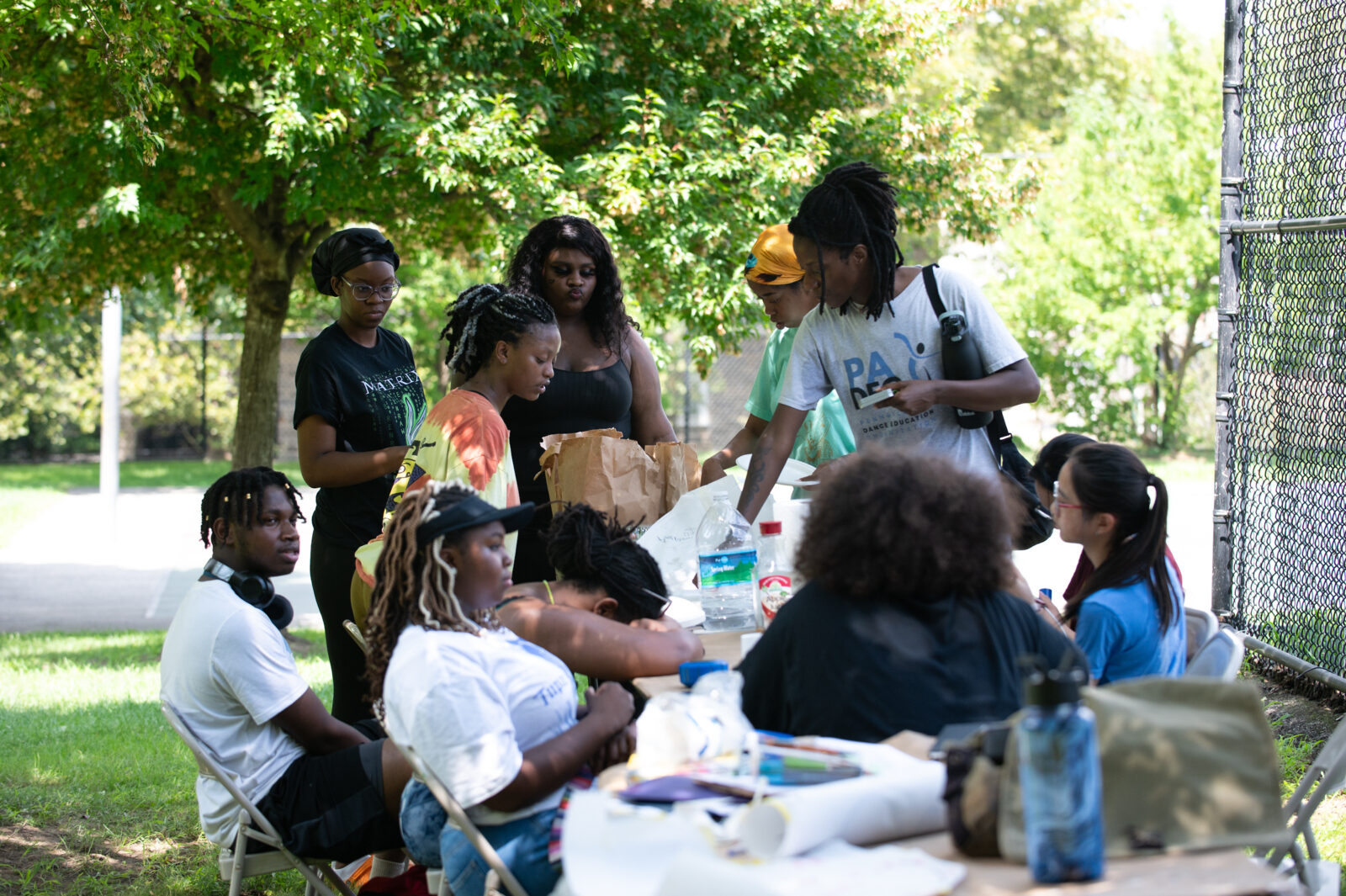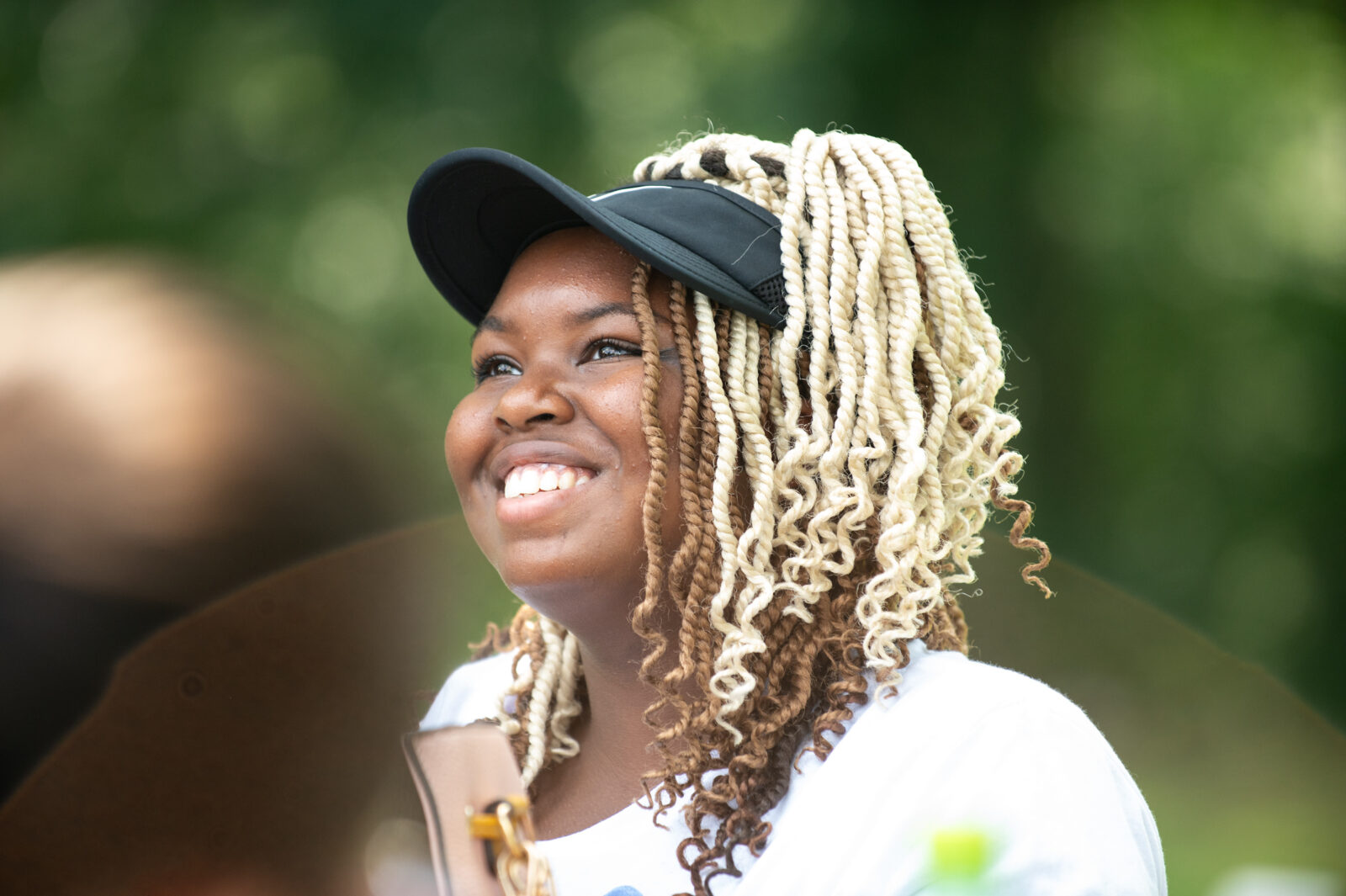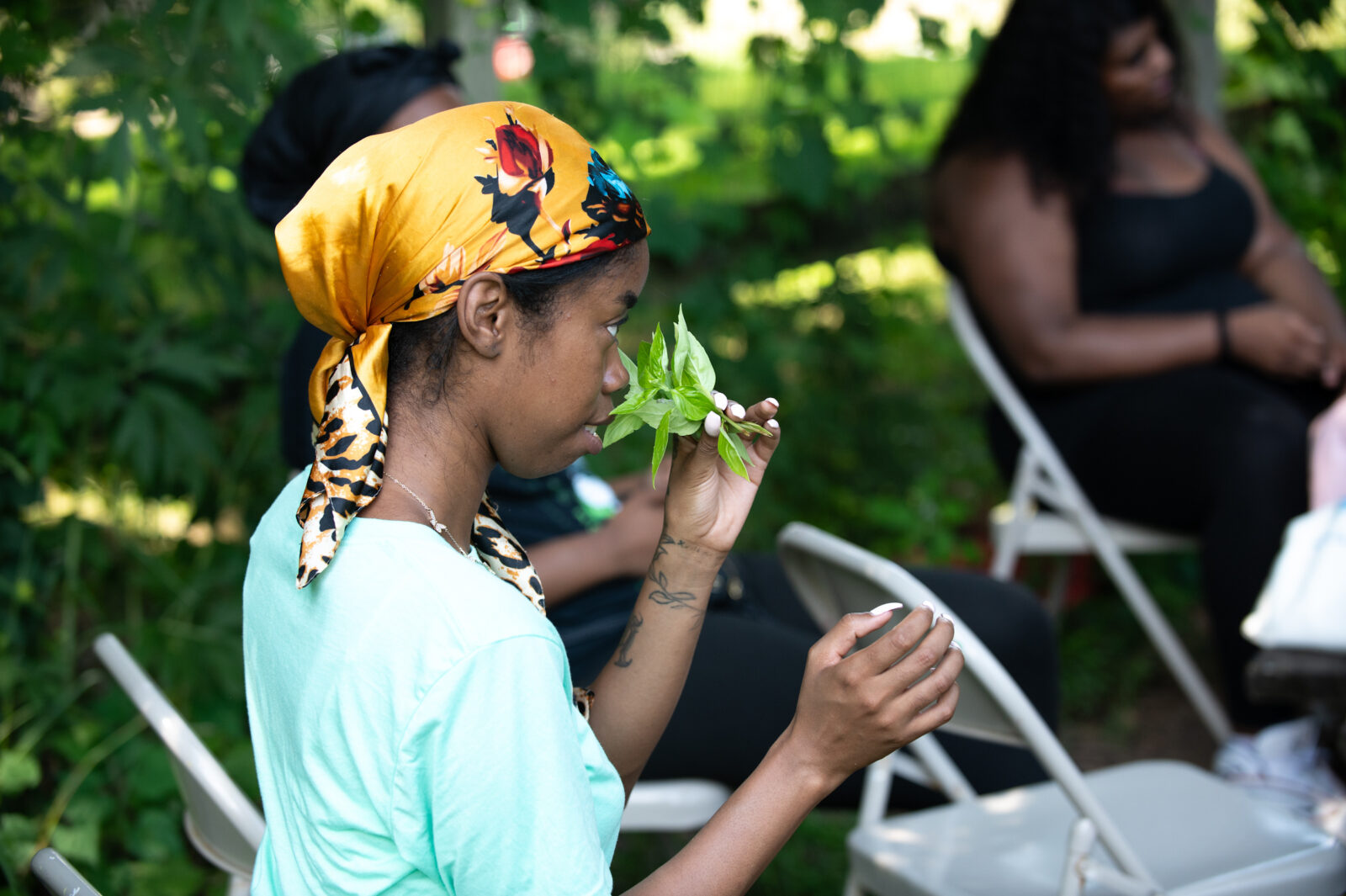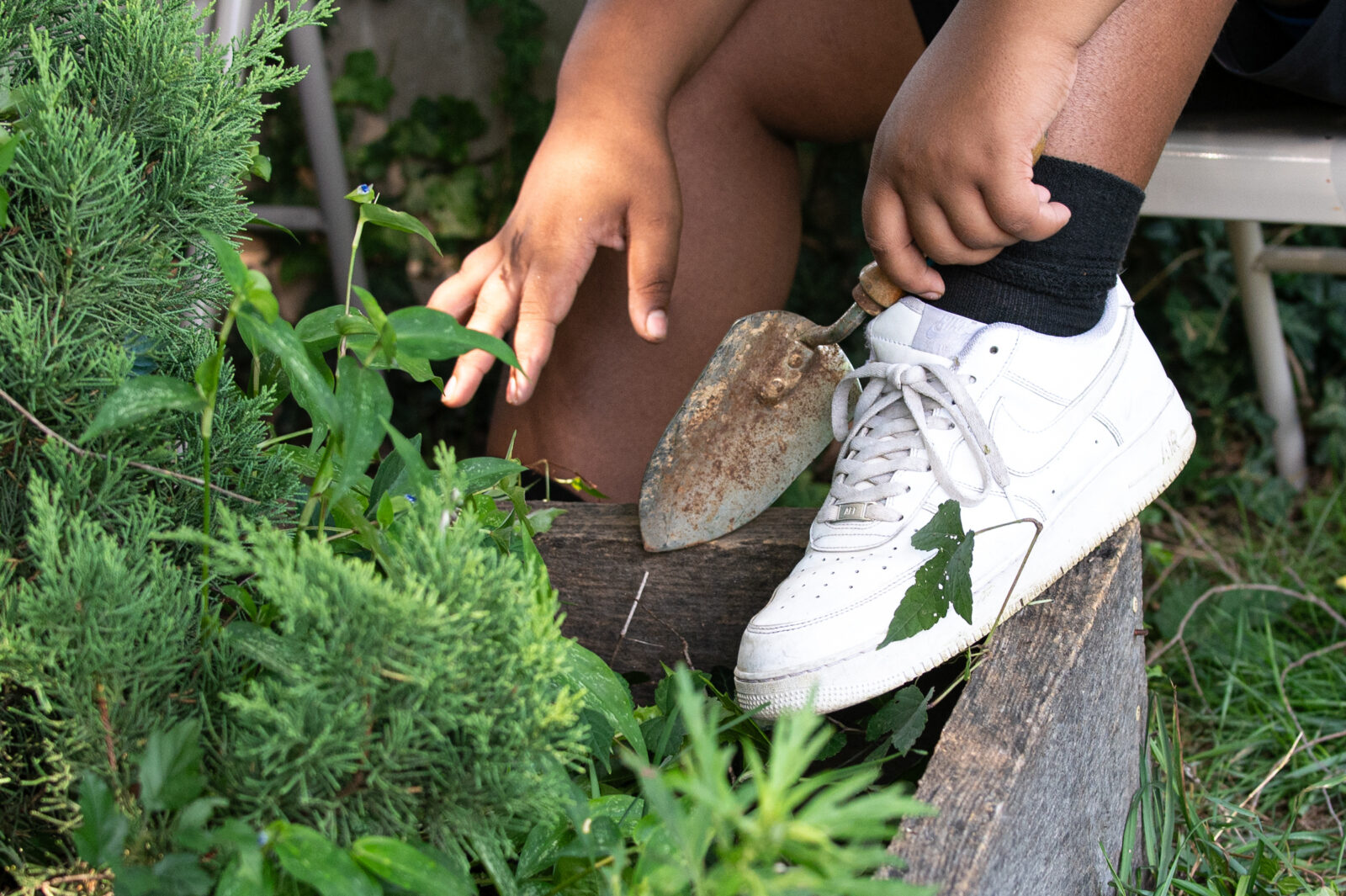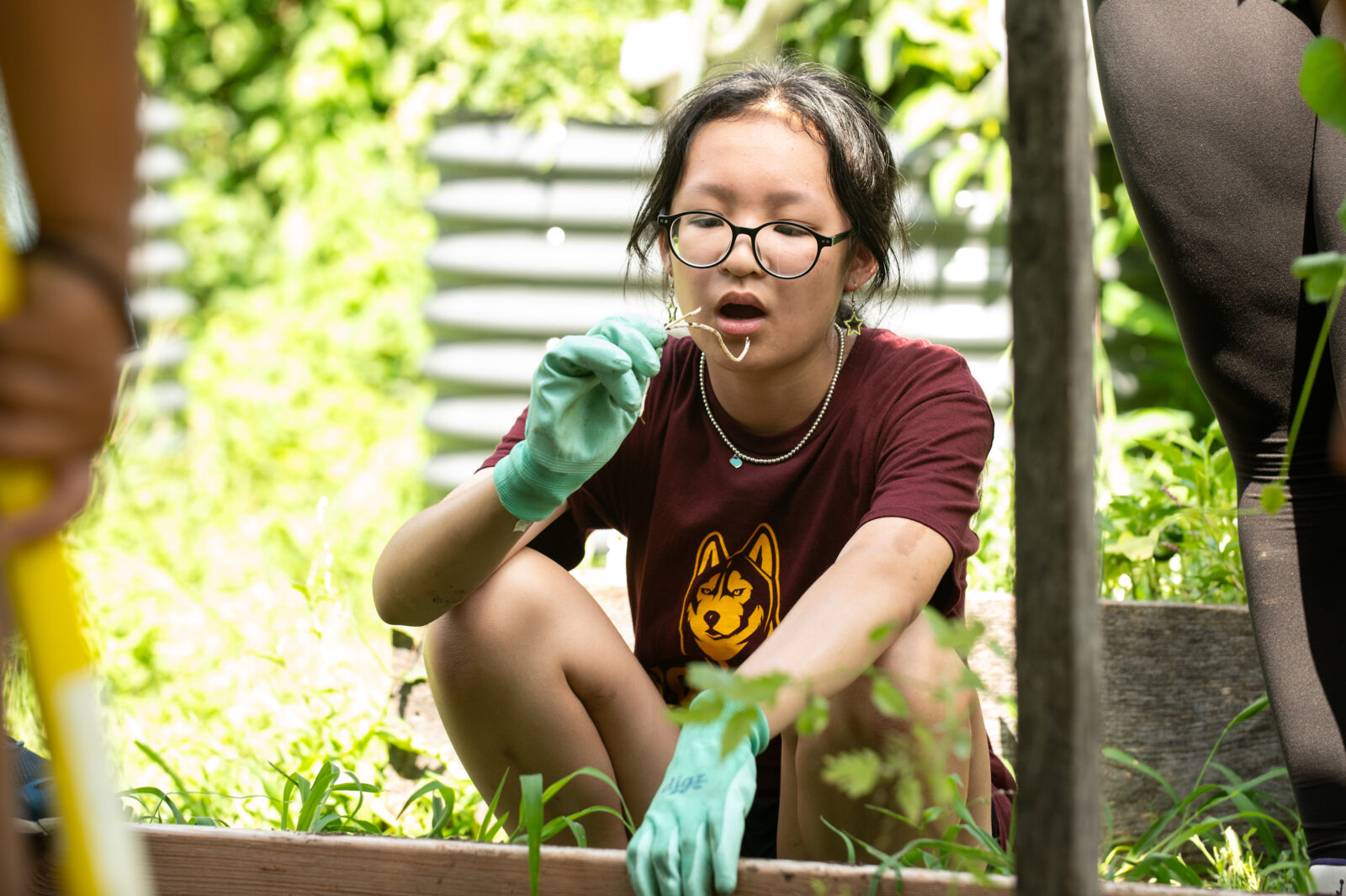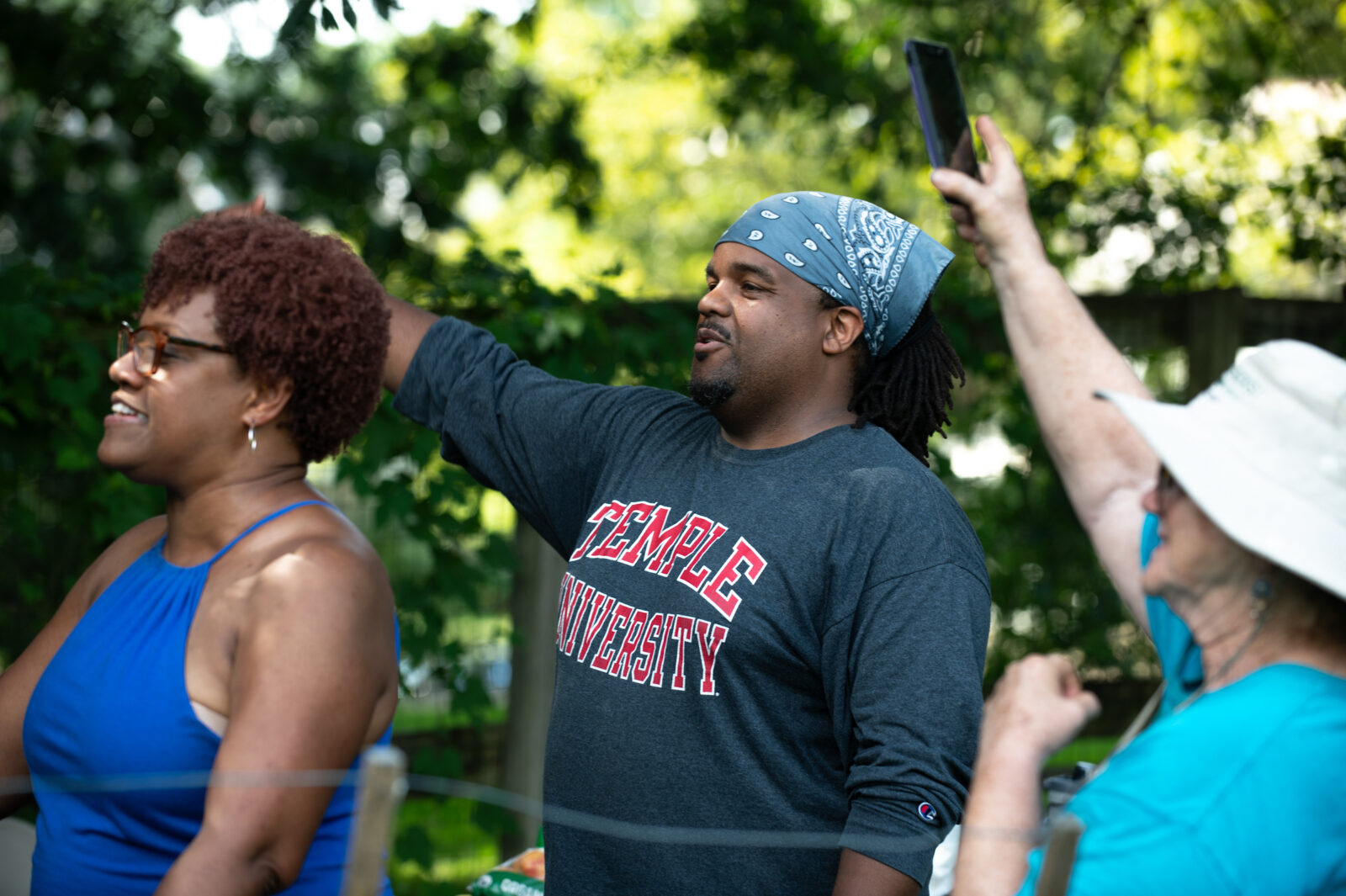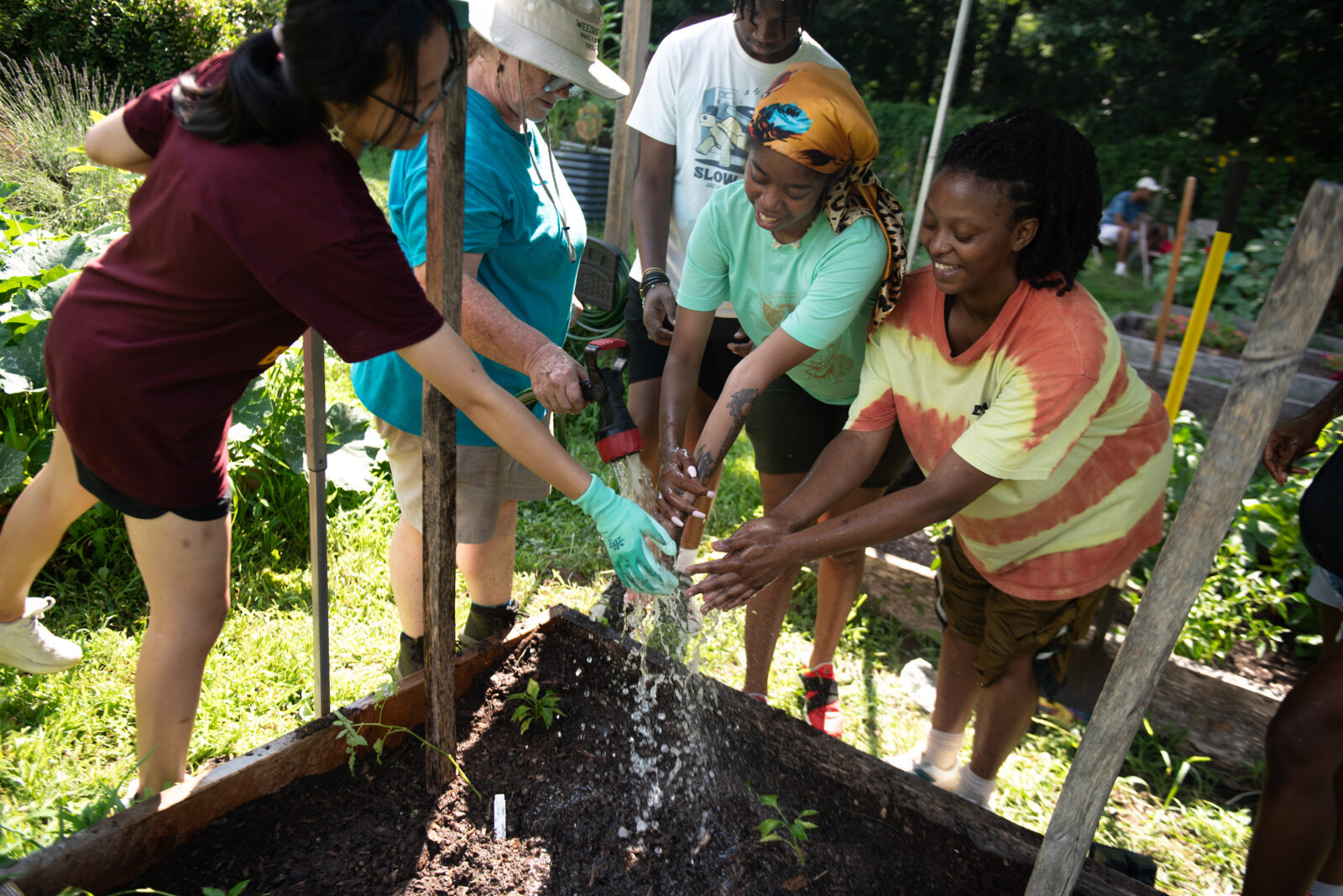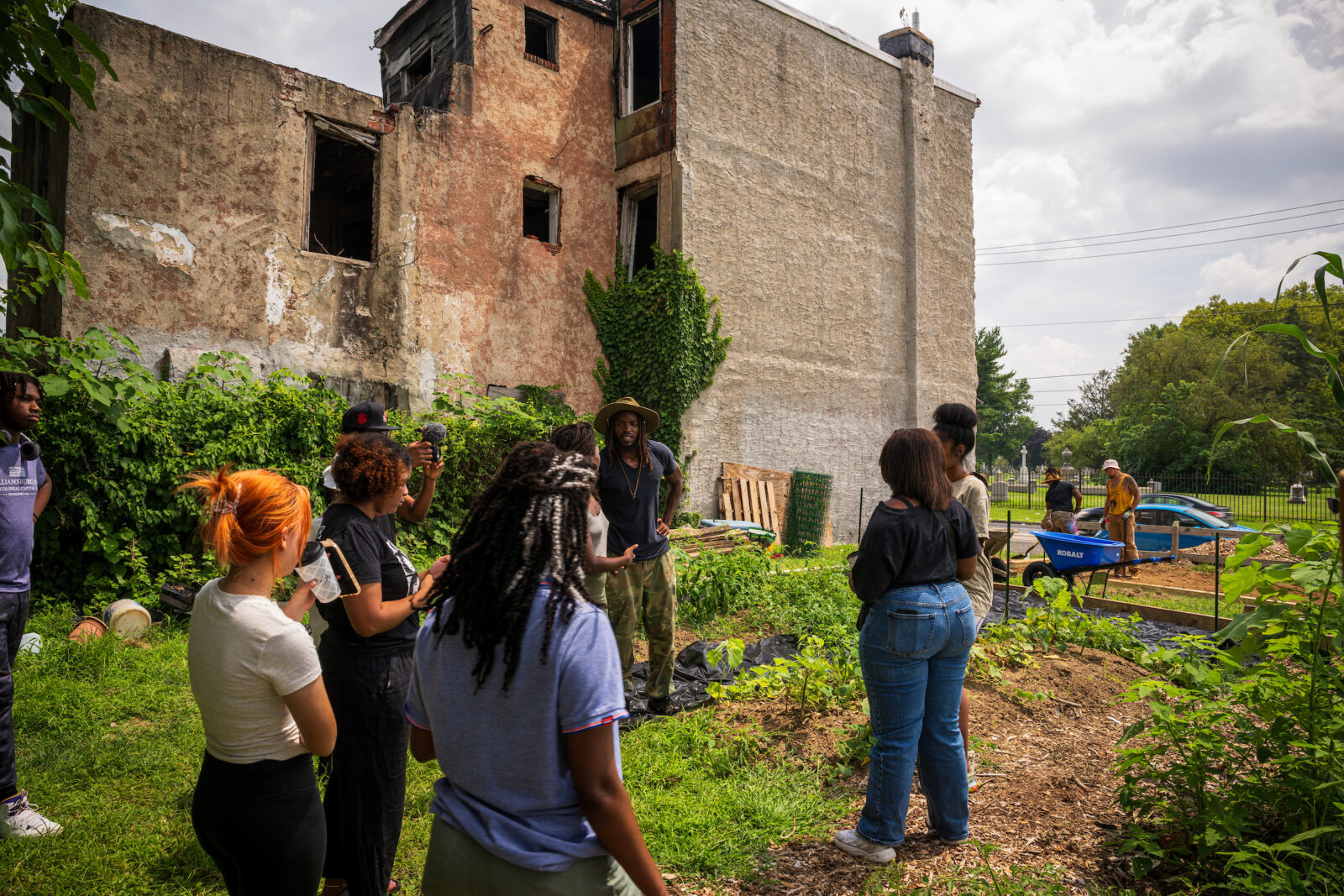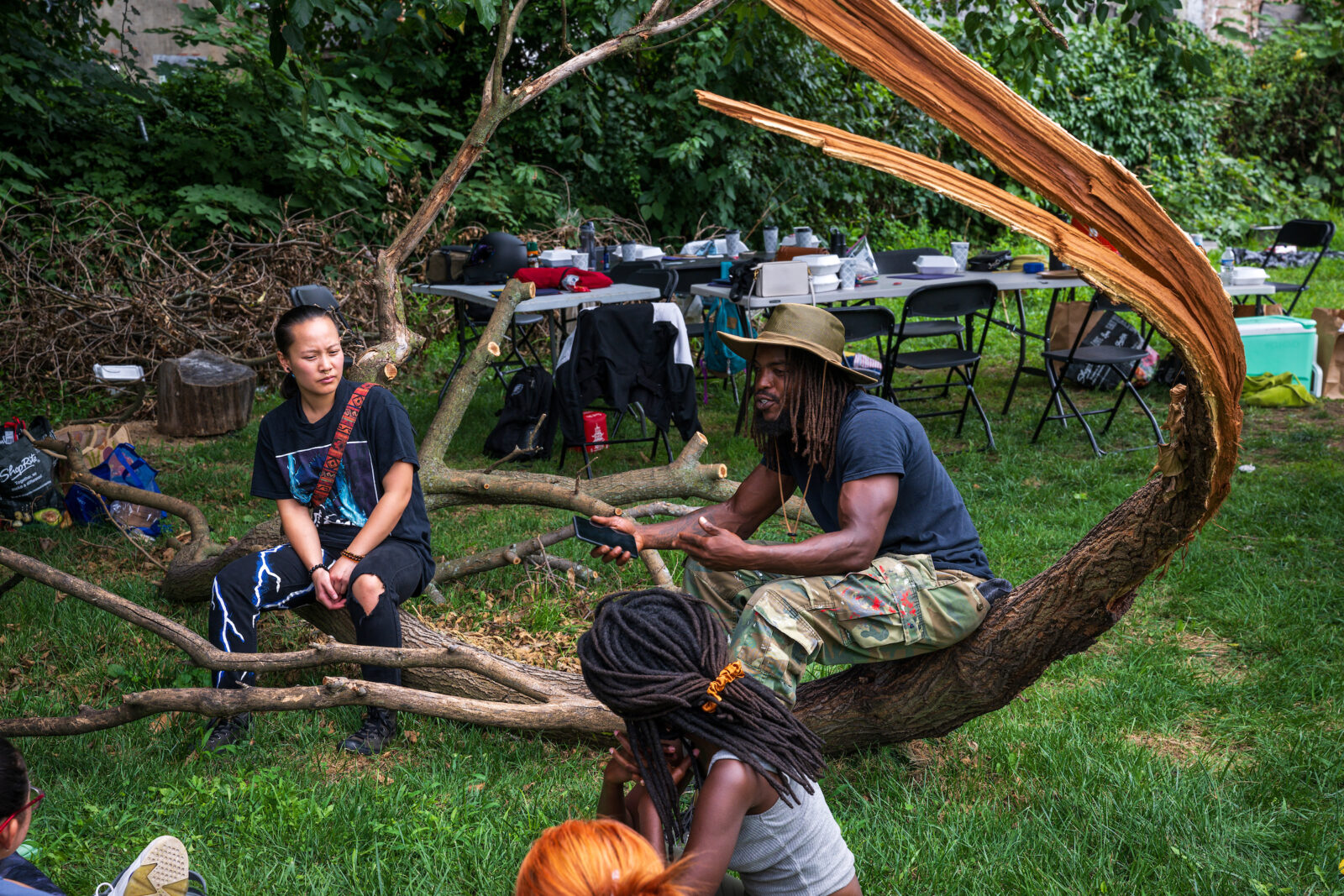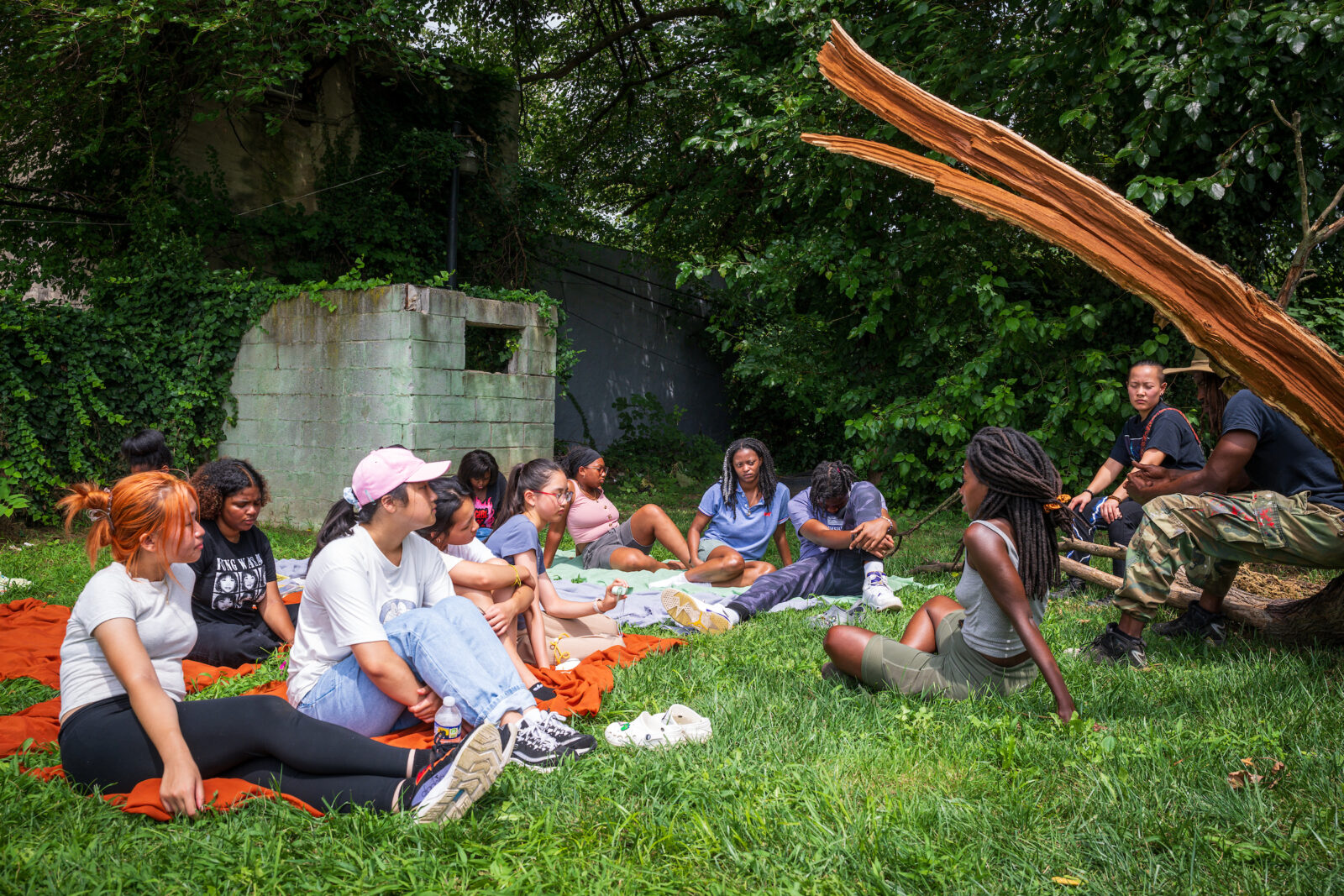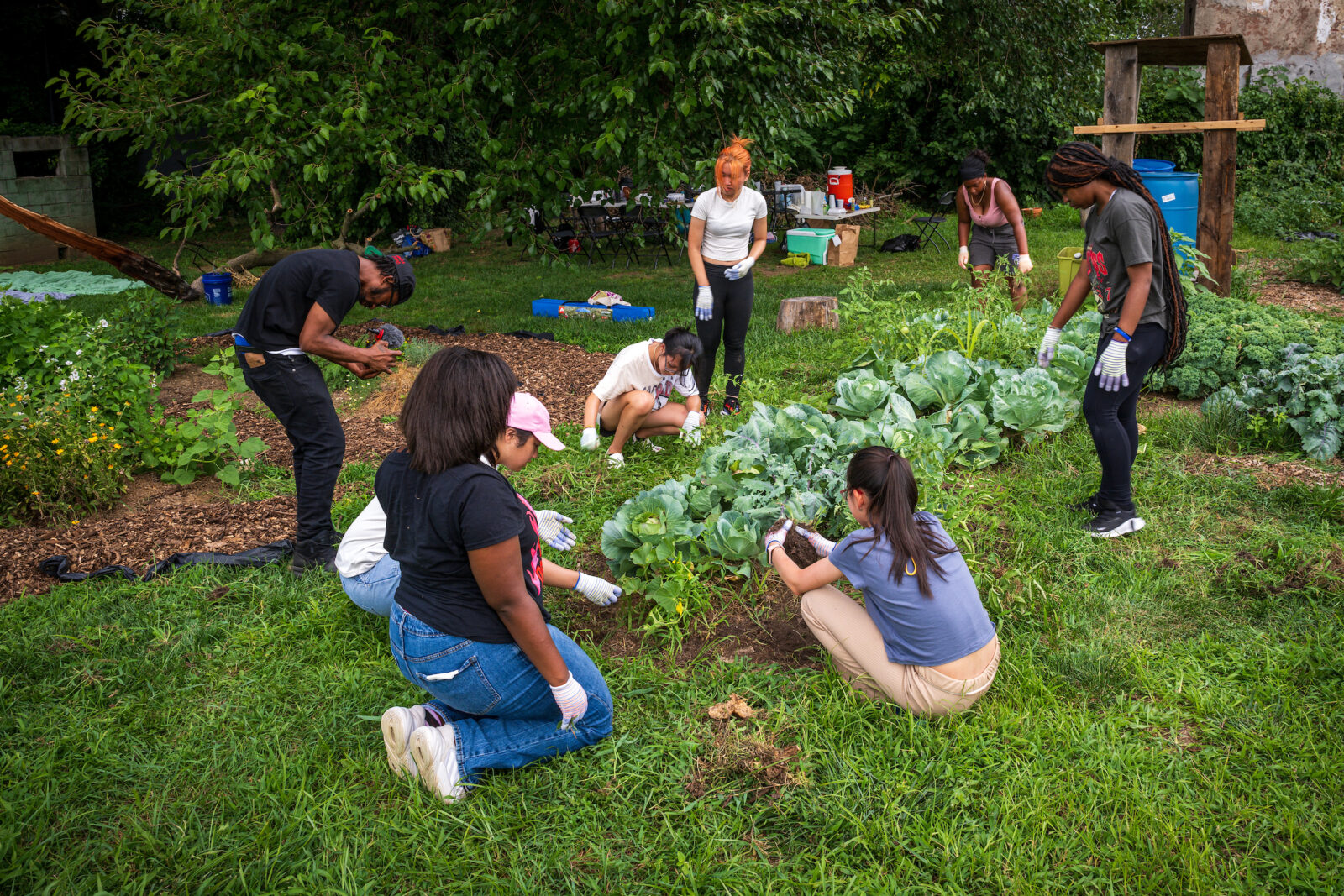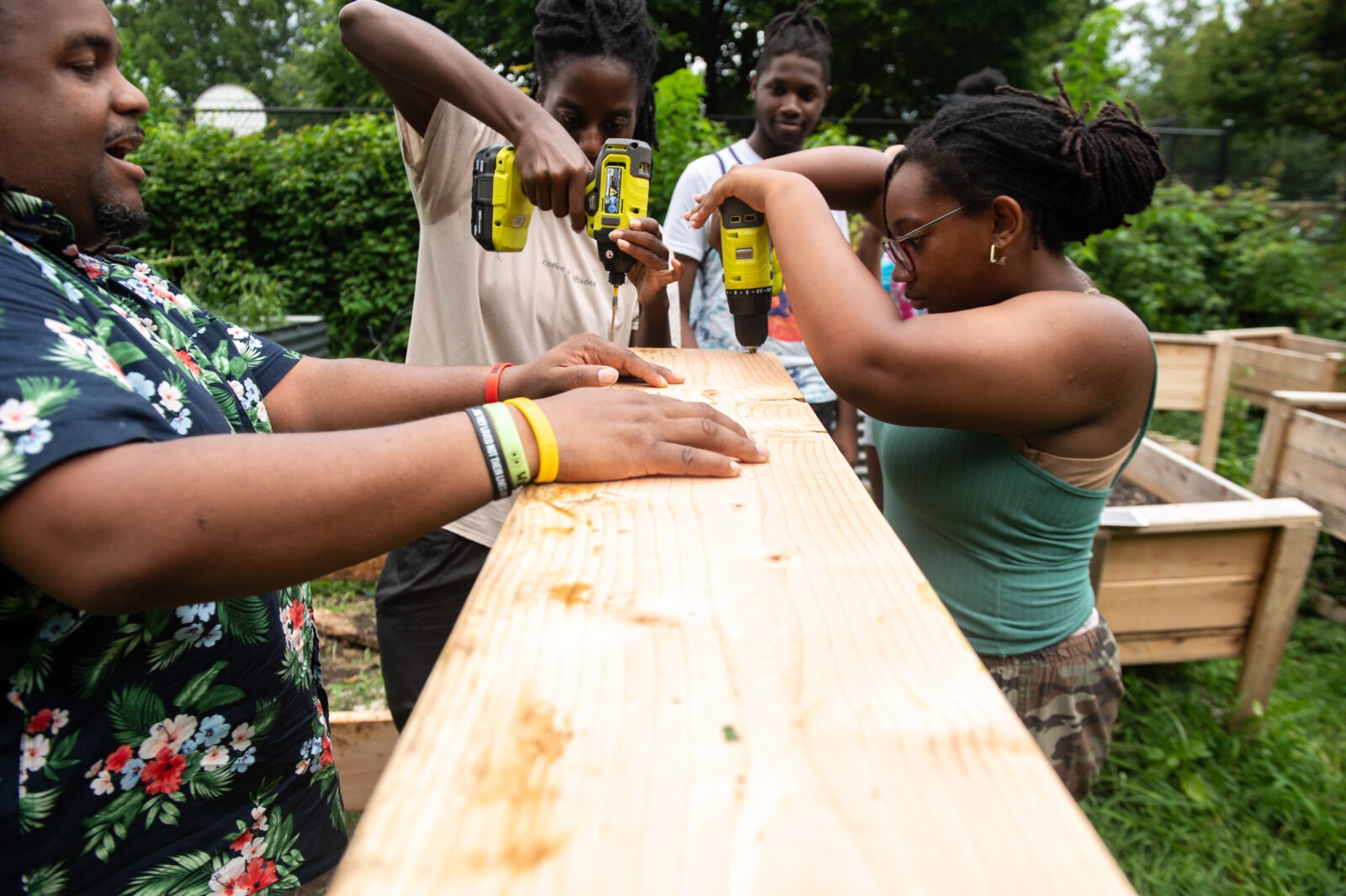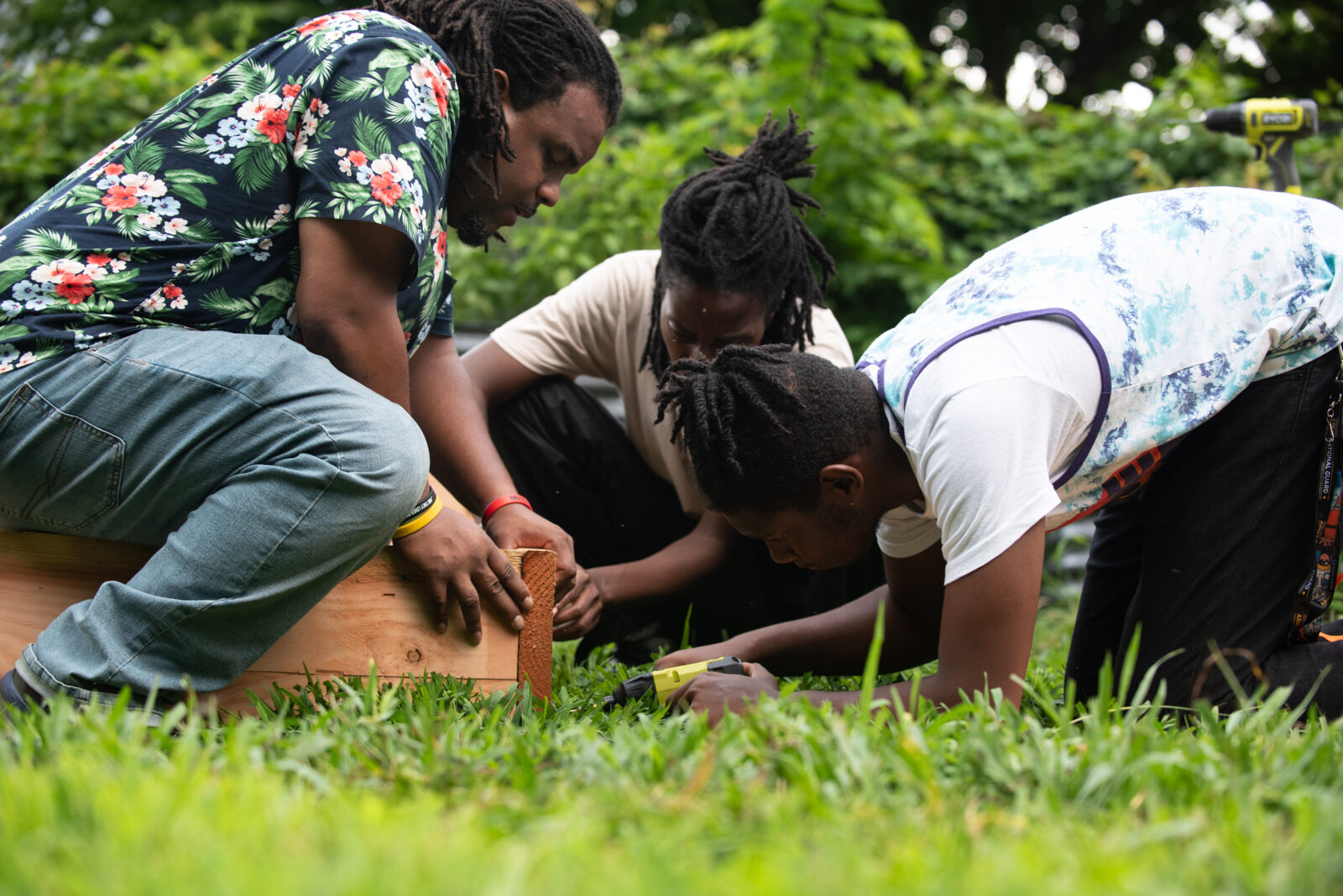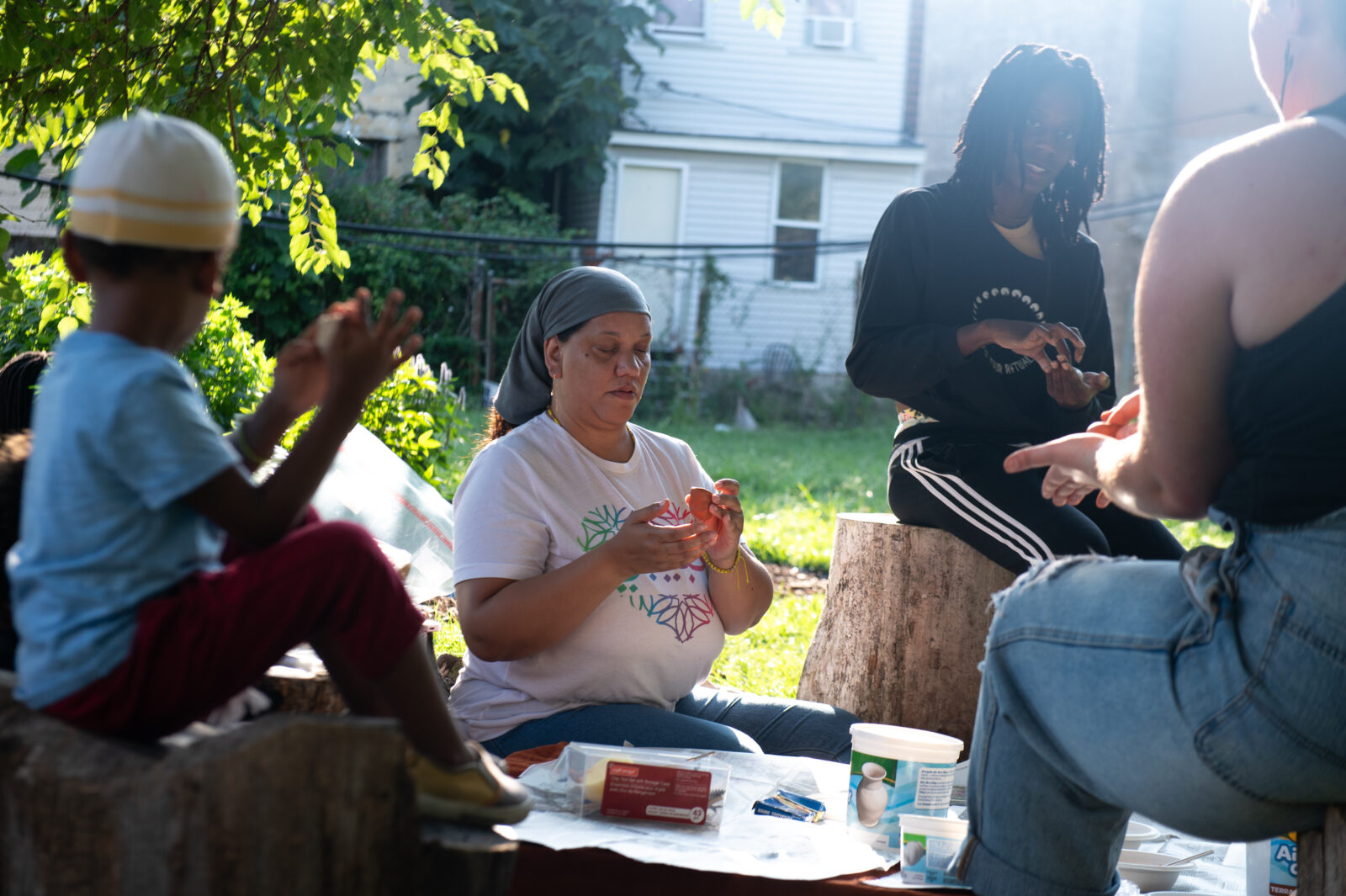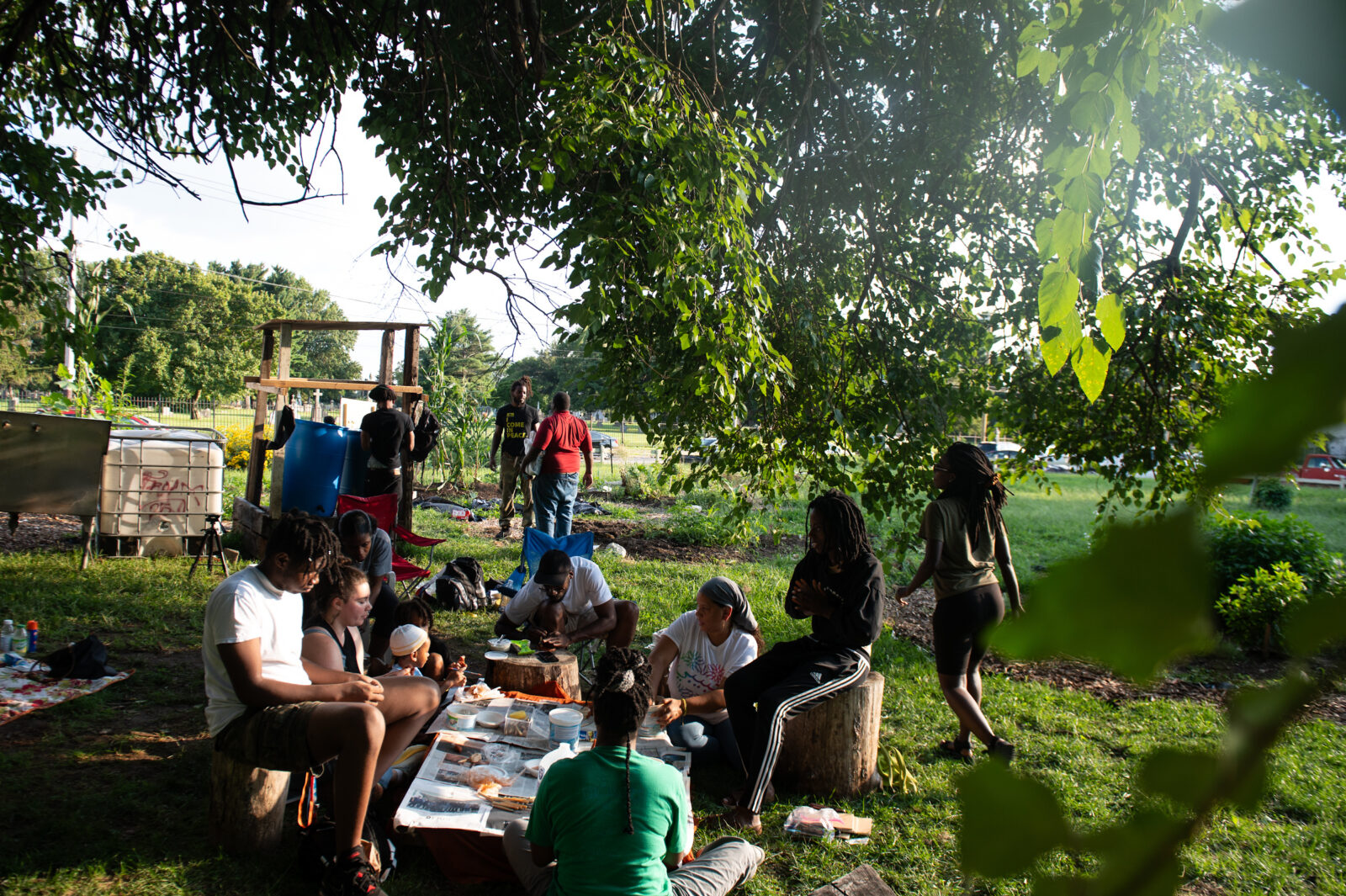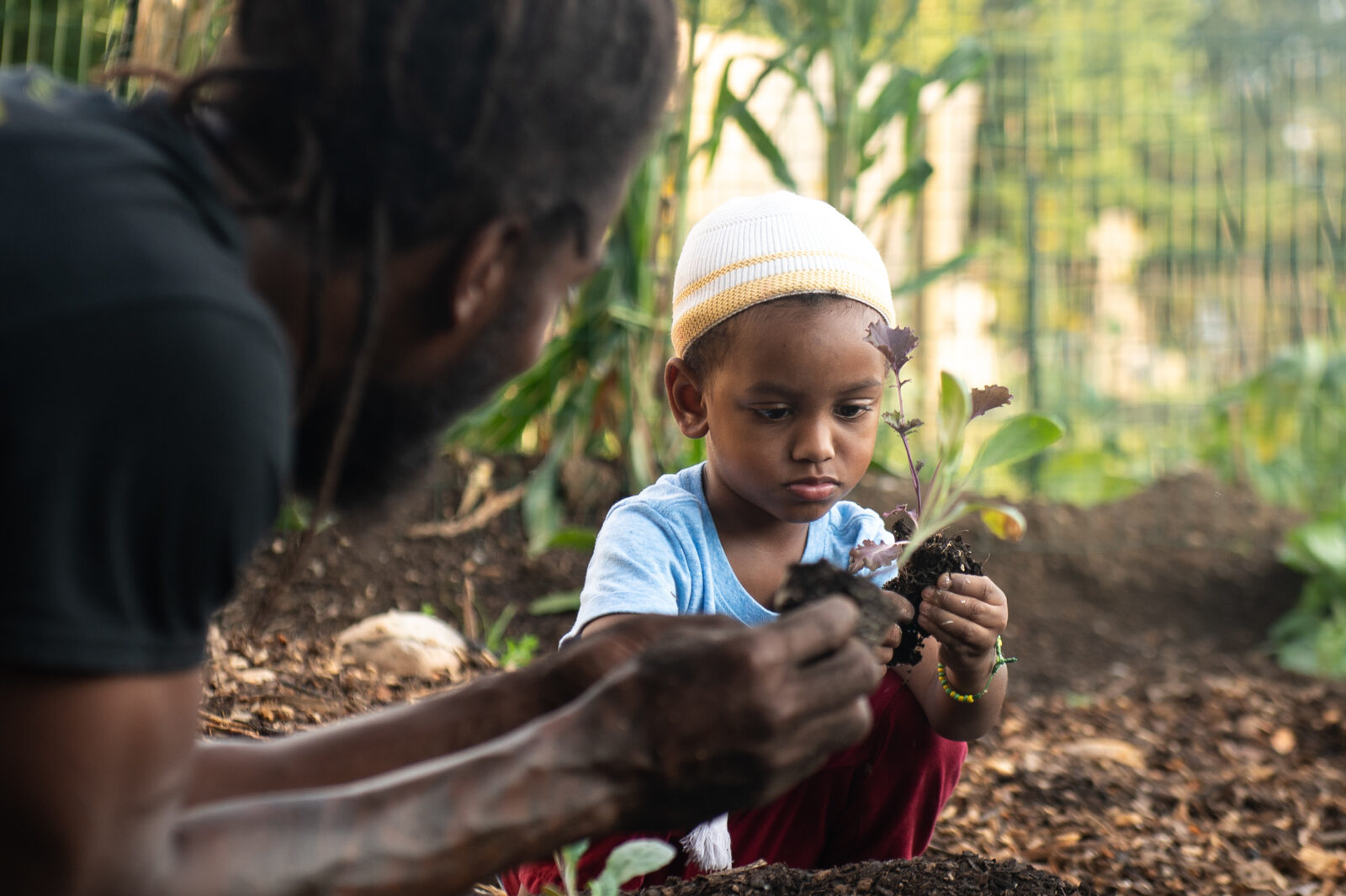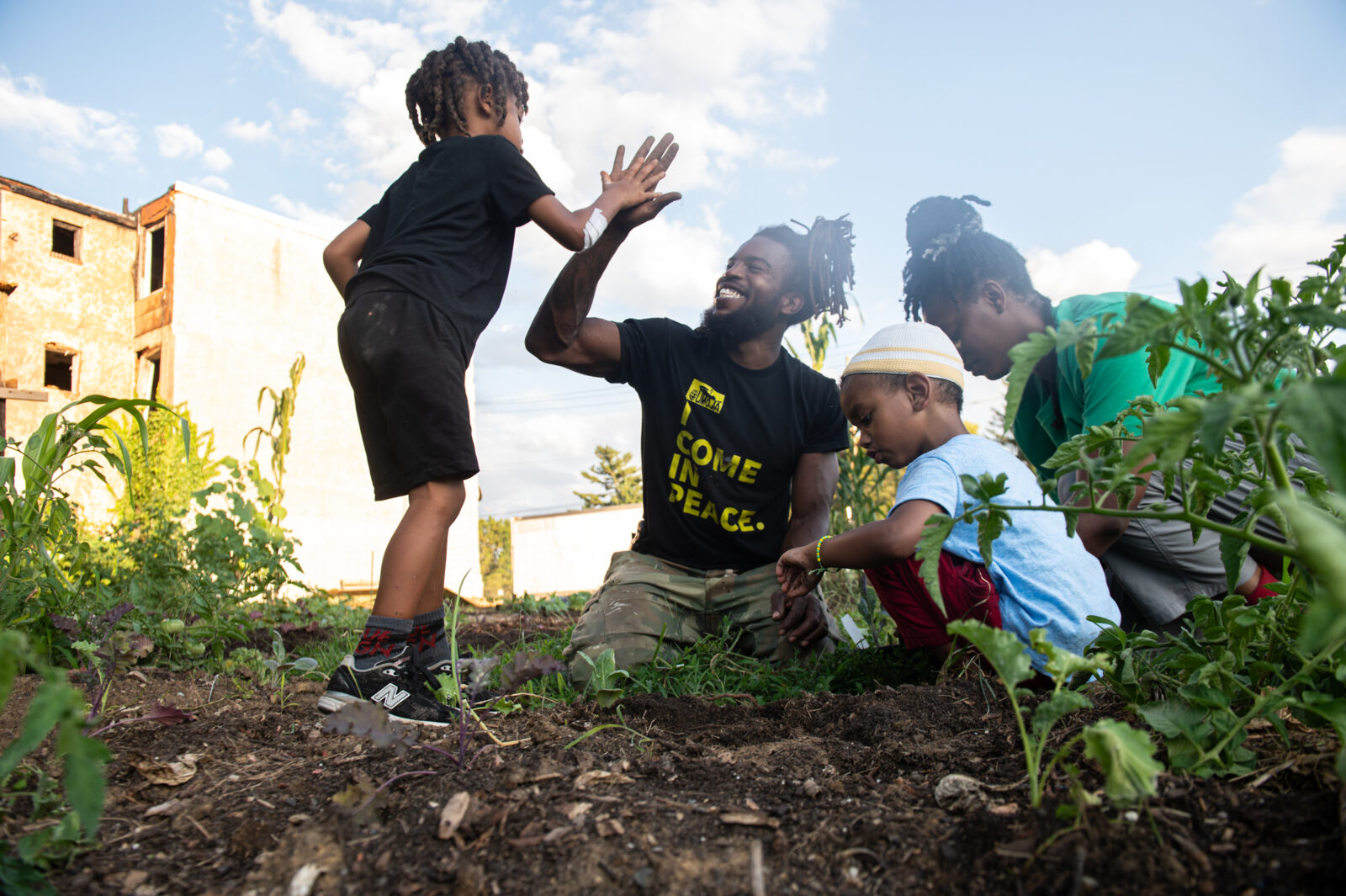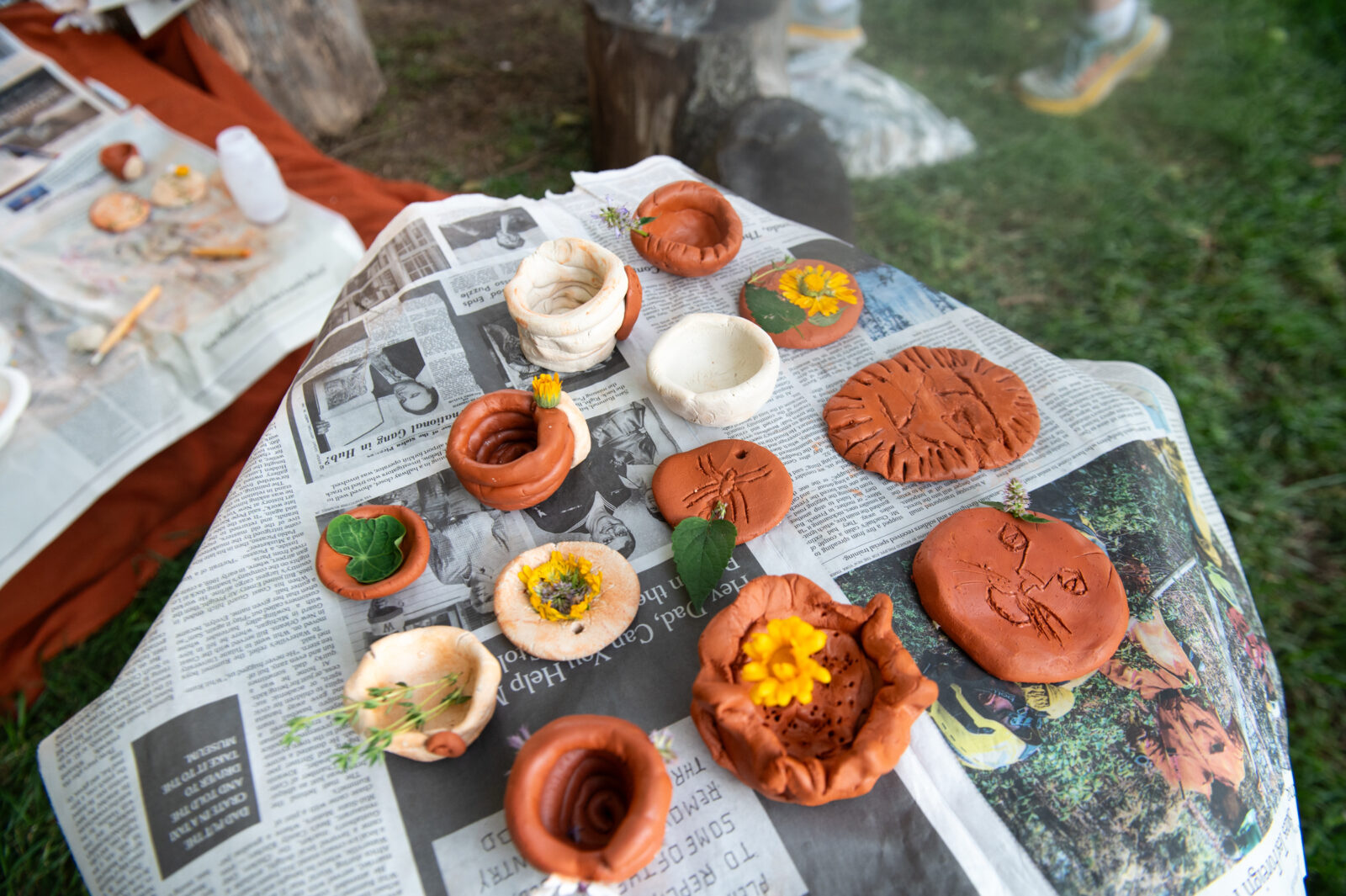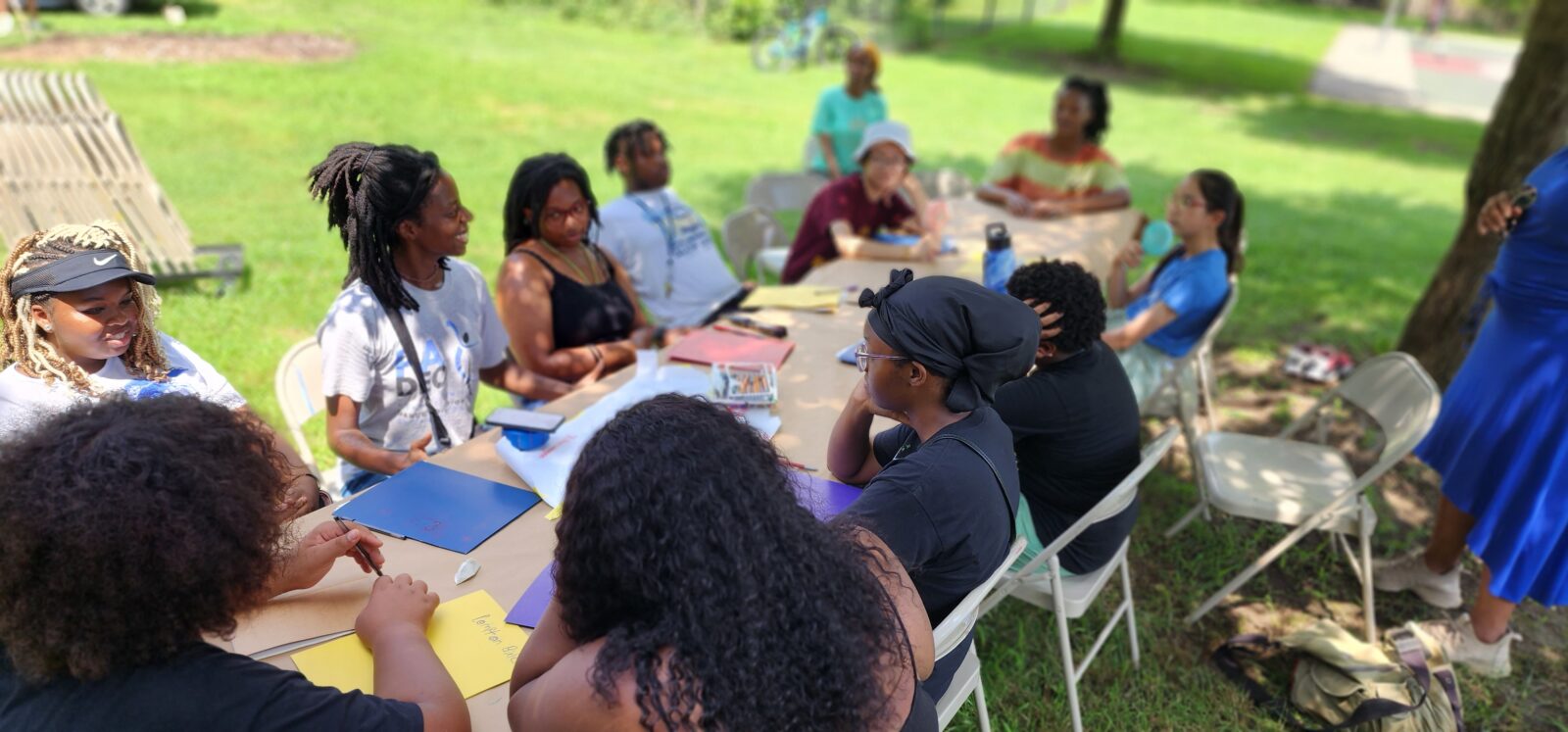Our Land, Our Movement
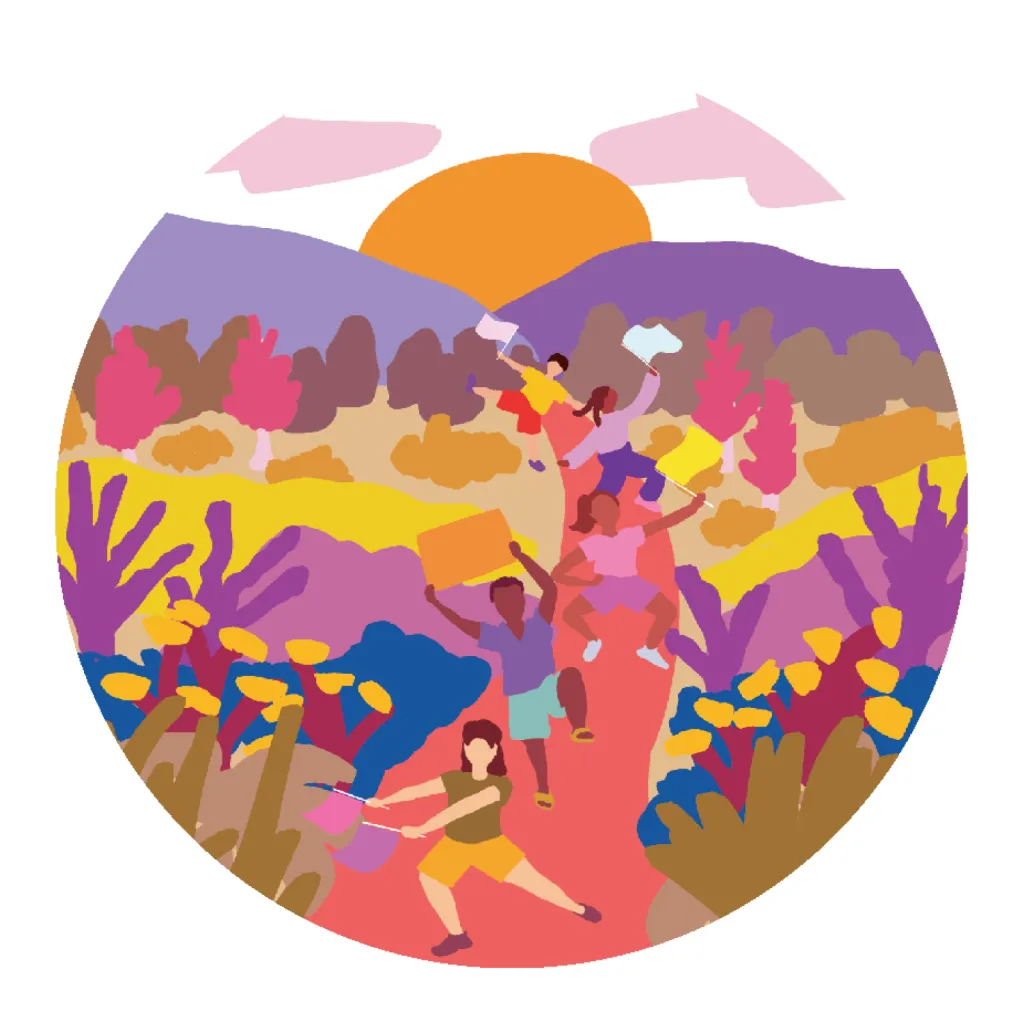
About the Project
Our Land, Our Movement is a public art project focused on healing our bodies and lands. Led by artist Marguerite Hemmings, this expansive series engages with communities living in West Philly, Olney and Chinatown who feel disconnected/unsafe/restricted from their bodies and neighborhoods. During the summer and fall of 2023, community members participated in free workshops by urban farmers and artist organizers. You can witness performances by teens in public spaces this September, and attend a dedication revealing new public artwork in November. We sat down with the artist to discuss the project.
Artist Interview: Meet Marguerite Hemmings
 What is your background as an artist?
What is your background as an artist?
I have been a choreographer and a movement/performing artist since I was 12 years old (informally), and formally for the past 19 years. While I’ve had many dance lives, right now I find my home in emergent, radical, improvised, ritual movement techniques and technologies. More recently I’ve been expanding into speculative writing and filmmaking, encountering and making stories of my own reparation as well as how other people, collectives, critters, and ghosts are making theirs. I went to school for Urban Studies and Education. I’ve worked with teens, middle schoolers and college aged people for over 20 years, using arts education as a way to know oneself deeper and have more strategies to maintain whimsy and creative power in a brutal world. Also I study and am obsessed with strategies of personal, social, and systemic change. I see all of this as the healing arts.
Can you give us an overview of how the project Our Land, Our Movement contributes to healing trauma?
Simply by being together. By having time to be together in spaces that are beautiful and filled with vibrancy and life.
I was deeply inspired by a series in 2020 led by Desiree Thompson called ‘Now Memories’. Thompson is a brilliant herbalist and body worker who made a call out to Black people who wanted to practice herbal medicine, outside. We met every week for the summer at a different park in Philadelphia and meditated with herbs. Healing can be simple. Deepening my connection with the land and the herbs deepened a connection with my body. I felt safer with myself, others, and my surroundings. It was in this container that I felt so clearly the power of being in communion and reverence with the land and each other.
Our Land, Our Movement is an ode to that gathering in 2020. Our Land, Our Movement is instead focused on teens, how to cultivate sacred spaces of belonging, safety, and protection, and is focused on the specific trauma of displacement. Displacement as ‘the act of moving something from its natural environment’. And we see this trauma play out on our bodies and our lands.
We’re working with teens this summer to see and respond to the effects of displacement on our bodies and our lands, which is a trauma that has been happening in many communities for generations. My theory is that people who are experienced with generational displacement have tools to build and carve out homes and sacred spaces where they can practice care, rest, and deep connection. And we can look to these tools to guide us into new ways of being with each other and the land in this current Covid reality.
We’re working with specific collective sacred space-makers in West Philly, Olney, and Chinatown. At Re-Entry Community Farm, stewarded by Stanley Morgan, tajah ebram, and a collective of many other folks, we’re seeing an example of responding to the effects of being displaced from your communities through incarceration. ReEntry is an invitation to come home, to make home with the land, our land.
In Chinatown we’re working with Yvonne Lung of Asian Americans United and learning about the movement to fight against the threat of an arena being built in Chinatown, risking the (further) displacement of a community who has carved out safe spaces where people can gather, set down roots, and grow. There we are asking the question, how do you protect the sacred spaces you create?
In Roots Garden/Fisher Park, stewarded by many, we’ve worked directly with Mark Smith, Laurel Sweeney, and Malik Henry, connected through Ambrose Liu at Olney Culture Lab, and learned from an example of a community coming together to recover and create a space of sanctuary for the multi-generational and multi-ethnic peoples of Olney.
Through these examples, the teens are getting practical knowledge of how to build and protect sacred spaces, as well as tap into a network of people and places that are deep in this practice. We’ve met at these different sites for a total of 10 weeks, taking part in workshops and talks, making herbal medicine, ancestor altars, molding clay, watering soil, planting seeds, building beds, and now making dances. It’s this sweating, building, and moving together outside in different neighborhoods that is re-wiring and expanding our sense of where we belong.
How do you see a connection between land (or space/place) and movement (our bodies)?
We relate to the land around us through movement and our bodies. We get to know the land through migration/movement. Restrictions on land affect the way we move and how and where we think we can move. When we can move freely, our relationship to the land becomes free. We reclaim our relationship with the land through our relationship with our movement and vice versa.
In the first session we talked about trauma and what it does to our nervous systems, making it sometimes impossible to get out of habits of flight, fight, and freeze, making it hard to connect to or see the resources around you. Some of the teens have talked about how their bodies are on high alert when they walk down the street because of fear of violence. That high alert rushes stress hormones/cortisol to the body, which shuts down important bodily functions, increases experiences of depression, anxiety, and further dissociates us from each other and our neighborhoods.
Trauma specialists like Peter Levine talk about how certain animals get out of these loops of fight, flight, or freeze through physical activity, i.e. shaking/shivering, running really fast, etc…waking the body up and out of the loop. This is why we dance. And this is why we dance outside. To re-organize our and the land’s nervous systems. To restore balance. Natural spaces directly calm the nervous system and re-teach our bodies how to regulate, breathe, and re-cycle.
I’m also connected to land and movement/body because of my interest in thinking about Indigenous studies, immigrant/migrant studies, and African Diasporic studies all in the same breath. In Indigenous studies we hear about the land as the site of settler colonial exploitation and what is in need of recovery and return. In African Diasporic studies, the body has become that center, or that site of decolonial, anti-capitalist struggle since it was/is the body and labor that was/is primarily exploited. In these questions of home and belonging, I wanted both the site of the land and the body to hold similar weight and importance.
What do you want the teen participants to get out of this experience?
We want the teens to learn strategies and tools to calm their nervous systems. We want them to make connections with other teens and sanctuary spaces in their neighborhood and other neighborhoods. To expand their sense of belonging to more than their neighborhood. To feel a sense of home that they can take with them anywhere that lives in their body. And also to experience taking care of the land and how that adds to their sense of belonging. We chose to work with teens because of their particular stage of development; they’re exploring more expanded social relations and ideas of the world, and also are vulnerable to abuse, control, and violence. We want to practice these tools of connection, growth, freedom, creativity, home, safety, and belonging so that they can know they can always tap into and create safe, nurturing spaces.
What do you want the larger community to get from it?
I’d love people to feel a sense of whimsy and vibrance through the experience of witnessing the teens in performance and these sanctuary spaces highlighted. Also a deeper attuning to the teens in their neighborhood and their worth. A deeper access to and knowledge of these sanctuary spaces. Also, time and space to gather together and practice being with the land.
About the Artist
Marguerite Angelica Monique Hemmings is a Jamaican born, Jersey-raised, NYC-made performance artist, writer, and social practitioner currently based in Philadelphia, USA. They focus on one’s own body, one’s own way of moving, adapting, healing, releasing, protecting, changing, and connecting to the unseen. They are a master of body ceremonies and a curator of vibes.
Marguerite uses body, text, media, and moving images in their work. They specialize in emergent, improvisational and social movement styles and technologies, rooted in the biomythography of the African Diaspora. They are researching the ancestral and subversive role of dance, and the dancer, throughout the African Diaspora and look to conjure these technologies through all of their (present) work.
Hemmings’ work is also embedded in alternative pedagogy and social practice/research. They have been subverting, working, and creating with youth as a teaching artist for over 15 years with programs such as The Possibility Project, University Settlement, and a co-founded initiative for the youth called New York Youth Movement Collaborative. They are an Associate Adjunct Professor at University of the Arts. They have received grants and fellowships from the Jerome Foundation, Brooklyn Arts Council, Harlem Stage, University Settlement, Dancing While Black, Urban Bush Women’s Choreographic Center Initiative, Arizona State University’s Projecting All Voices Fellowship, Abrons Arts Center, Headlong Performance Institute, and the Foundation for Contemporary Arts to further their research. They’ve received a Bessie Award for Outstanding Performer in Eva Yaa Asantewaa’s Skeleton Architecture. They currently work inside of a self/spirit directed practice called we free. we free looks at the millennial and gen z approach to liberation through its music, social dance and social media, as well as lives in a speculative world where freedom has already been secured a long, long time ago.

The “Our Land, Our Movement” project was generously funded by Porch Light partner DBHIDS and the Van Ameringen Foundation. For more information and updates about “Our Land, Our Movement” and to attend an event, please visit the Mural Arts Philadelphia website at muralarts.org/our-land-our-movement.
